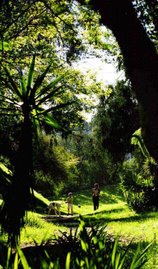Photo: Futterer, Holyland Exhibition, 1960. Grading for the 2 Freeway involved moving a lot of earth, as seen from the Holyland Exhibition at the corner of Allesandro Way & Lake View Ave. (Click on photo to enlarge.)
It's been 50+ years since our neighborhood has seen anywhere near the amount of earth moving we'll be in for if all the projects approved in recent years break ground (some already have): Semi Tropic Spiritualists' Tract, Monte Sano, DWP projects, Menlo Property, Coffee Table site, Bert Co site, 2 Freeway Terminus and Taylor Yard. Now there are rumors of a complete tear-down/rebuild of the Ralph's shopping center on Glendale Blvd.
Several years ago, the Silver Lake Neighborhood Council's Urban Design & Preservation Advisory Committee and Silver Lake Improvement Association kept bringing up the cumulative effects, including serious health effects, of all these projects in the pipeline, but City Planning failed to acknowledge them.
1960 - 1962 our neighborhood saw earth moving on an unimaginable scale: 2 Freeway, 5 Freeway and Dodger Stadium dramatically changed the neighborhood's landscape. 50 years ago, no one knew just how all that unmitigated dust would effect our health.
Over the past 10 years, a significant volume of research has confirmed the health risks of living near freeways and rail yards - sources of diesel particulate matter. There is no shortage of studies confirming the risks, including heart disease, COPD, asthma, chronic bronchitis, cancer, premature death, premature birth and low birth weight.
Health risks to children are particularly high, since their lungs are still developing. The elderly and those with chronic heart & lung problems are at greater risk of premature death.
People who live close to sources of diesel particulate matter are more susceptible to increased levels of particulate matter that come with construction sites. To simplify, it's microscopic, you can't see it or smell it and it can kill you.
So, we will look at air quality issues at least once a week as they relate to neighborhood projects.



